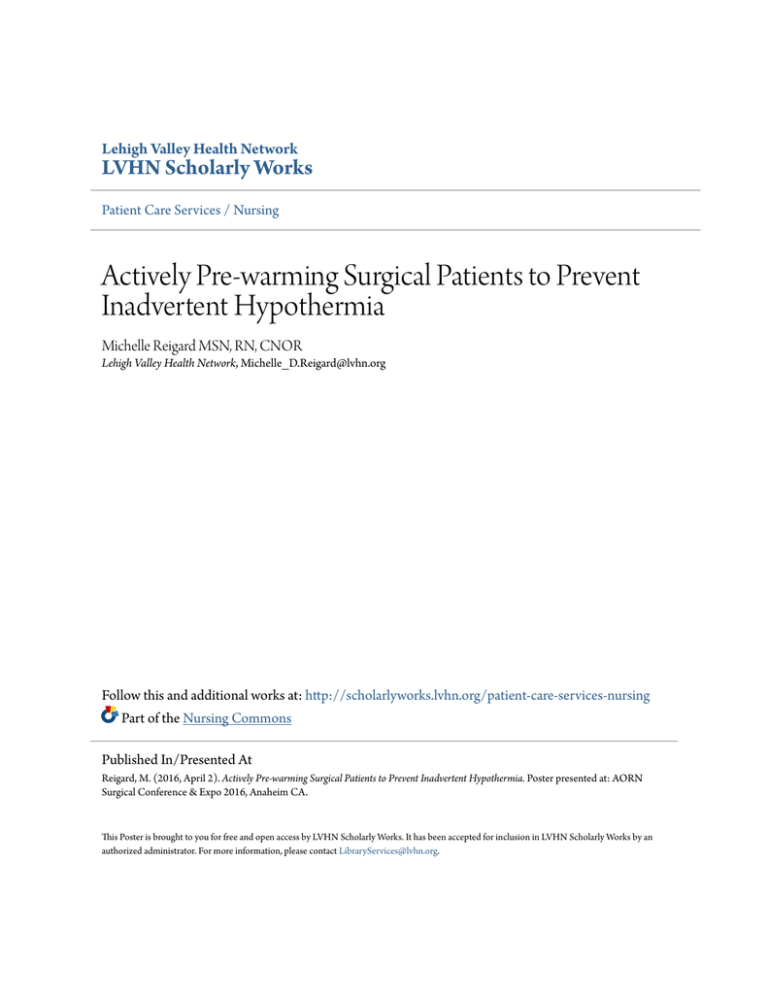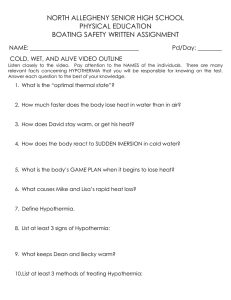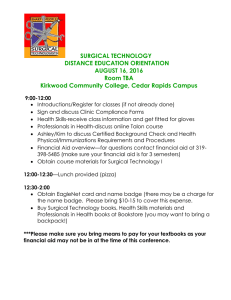Actively Pre-warming Surgical Patients to Prevent Inadvertent
advertisement

Lehigh Valley Health Network LVHN Scholarly Works Patient Care Services / Nursing Actively Pre-warming Surgical Patients to Prevent Inadvertent Hypothermia Michelle Reigard MSN, RN, CNOR Lehigh Valley Health Network, Michelle_D.Reigard@lvhn.org Follow this and additional works at: http://scholarlyworks.lvhn.org/patient-care-services-nursing Part of the Nursing Commons Published In/Presented At Reigard, M. (2016, April 2). Actively Pre-warming Surgical Patients to Prevent Inadvertent Hypothermia. Poster presented at: AORN Surgical Conference & Expo 2016, Anaheim CA. This Poster is brought to you for free and open access by LVHN Scholarly Works. It has been accepted for inclusion in LVHN Scholarly Works by an authorized administrator. For more information, please contact LibraryServices@lvhn.org. Actively Pre-warming Surgical Patients to Prevent Inadvertent Hypothermia Michelle Reigard, MSN, RN, CNOR Perioperative Services, Lehigh Valley Health Network, Allentown, PA Previous Practice •Prewarmed all surgical patients passively with a warm cotton blanket. •Intra-operatively warmed high risk surgical patients with a warm forced-air blanket. Problem •68% of high risk patients became hypothermic after 15 minutes of induction. •Hypothermia leads to multiple complications: –Increased bleeding –Increased surgical site infections –Increased postop pain –Increased risk of cardiac arrhythmias –Delayed healing –Decreased metabolism of anesthetic drugs –Prolonged intubation time –Increased recovery room time –Increased healthcare cost –Decreased patient safety and clinical outcomes Evidence •Purpose: To determine if pre-warming surgical patients with warm forced-air decreases the incidence of inadvertent hypothermia in the surgical patient. •PICO Question: In adult surgical patients, does actively pre-warming a patient with warm forced-air compared to passively pre-warming a patient with a cotton blanket decrease the incidence of patients becoming hypothermic during the intraoperative and postoperative phase? P: Adult Surgical Patients I: Active pre-warming with warm forced-air. C: Passively pre-warming with a warm cotton blanket O: Decrease the incidence of inadvertent hypothermia. •Evidence from Literature Review: Actively Pre-warming with a forced-air warming system for at least 30 minutes is significantly more effective in keeping surgical patients normothermic and preventing hypothermia than passively pre-warming with a cotton blanket. Implementation Development •Create Pilot Committee: Multidisciplinary Team •Literature Review: Determine evidence for best practice. •Evaluation & Purchase: Forced-Air Warming System •Create: Policy and Standard Work for actively pre-warming high risk surgical patients with warm-forced air. •Staff Education & In-servicing on: Inadvertent Hypothermia, high risk patients, policy, and standard work for pre-warming high risk surgical patients. •Staff Training & Validations: Return demonstration and Validation Checklist for using forced-air system according to manufactures instructions. •Install: Forced air-warming units. •Pilot Study: Implemented active pre-warming at one campus. •Data collection and analysis: Positive results •Disseminated Practice: Throughout Network in periop. Results •Prevented high risk patients from becoming hypothermic after 15 minutes of induction. •Decreased postoperative complication resulting from inadvertent hypothermia. •Increased patient comfort •Increased patient satisfaction •Increased patient’s clinical outcome, safety and quality of care •Decreased healthcare cost Challenge/Barriers •Cost of forced-air unit and supplies •Minimal barriers faced due to staff’s involvement in the process change and the simplicity of using the forced-air warming system. High Risk Factors •Age: The elderly and pediatric patients •Size: Thin patients •Physical Status: Patient’s with pre-existing conditions. •Length and Type of Surgery: Long, open cavity procedures. •ERAS Patients: All GYN, GYO and Colorectal procedures. Practice Change •Baseline temperature on admission •Actively pre-warming surgical patients, who are at high risk for inadvertent hypothermia, for at least 30 minutes with a forced-air warming system to preventing hypothermia throughout all phases of surgery References: 1.Benson, E. E., McMillan, D. E., & Ong, B. (2012). The effects of active warming on patient temperature and pain after total knee arthroplasty. AJN, 112(5), 26–33. 2.Croft, M.J. (2010). The impact of preoperative warming of ambulatory surgery patients on the prevention of postoperative hypothermia. Unpublished master’s theses, dissertation and graduate research, Rhode Island College. Retrieved from http://digitalcommons.ric.edu/cgi/viewcontent.cgi?article=1019&context=school_of_nursing. 3.Hooven, K. (2011). Preprocedure warming maintains normothermia throughout the perioperative period: A quality improvement project. Journal of PeriAnesthesia Nursing, 26(1), 9–14. 4.Horn, E. P., Bein, B., Bohm, R., Steinfath, M., Sahili, N., & Hocker, J. (2012). The effect of short time periods of pre-operative warming in the prevention of peri-operative hypothermia. Anesthesia, 67, 612–617.doi:10.111/j.1365-2044.2012.07073.x 5.Lynch, S., Dixion, J., & Leary, D. (2010). Reducing the risk of unplanned perioperative hypothermia. AORN Journal, 92(5), 553–565.doi:10.1016/j/aorn.2010.06.015. 6.Nei, J., Prescolt, D., & Layne, C. (2011). Forced-air warming gowns to prevent unintentional surgical hypothermia. Journal of PeriAnesthesia Nursing, 26(3), 189–190. doi: http://dx.doi.org/10.1016/j.jopan.2011.04.035. 7.Shin, KM., Ahn, JH., Kim, S., Lee, JY., Kang, SS., Hong, SJ., & Chung, HM. (2015). The efficacy of pre-warming on reducing intraprocedural hypothermia in endovascular coiling of cerebral aneurysms. BMC Anesthesiology, 15(8), 1–7. Retrieved from http://www.biomedcentral.com/1471-2253/15/8. 8. Wu, X. (2013). The safe and efficient use of forced-air warming system. AORN, 97(3), 302–308. doi:10.1016/j.aron.2012.12008. © 2016 Lehigh Valley Health Network


